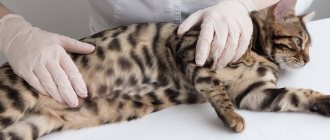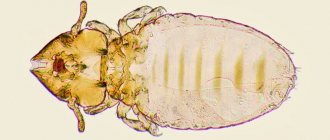Ringworm in cats is a fungal infection of an animal. What is the cause of the disease? In the first place is infection. Reduced immunity, allergies, and viruses are also prerequisites for the disease. More recently, 20 years ago, even 10 years ago, the disease was considered incurable. Pets were euthanized. Fortunately, today lichen in cats and kittens can be treated. The disease is contagious; it can infect other animals and, which is very unpleasant, people.
It is necessary to be vigilant and at the first signs of deprivation (we will talk about them a little later) not to self-medicate, but, having grabbed your pet, come to an appointment with a veterinarian for an accurate diagnosis. Many people encounter this for the first time, panic, search on forums, ask friends what to do? Yes, you can listen to advice, but! you should calm down and come with your cat to a doctor's consultation. By being patient and receiving the necessary treatment methods, you can help your pet recover.
In the article we will talk about the types of ringworm, its symptoms, and will dwell in more detail on the treatment of ringworm and prevention.
Types of lichen in cats
True types of lichen in cats include the following diseases:
- Trichophytosis
- Microsporia
- Favus (Narsha)
Such types of cat lichen as: ringworm, pityriasis versicolor, pink and red lichen are not entirely scientific from a veterinary point of view, but are most understandable for animal owners.
Animal owners often classify lichen as a skin disease with a similar course, but caused by completely different factors and pathogens. For example, by weeping lichen, owners most often mean eczema - a completely different skin disease. In some cases, these are bacterial dermatitis.
What does ringworm look like in cats?
Ringworm in cats appears as multiple, limited areas of hairless, flaky skin. Around the source of the disease, the hair is usually brittle, it is shorter than the hair on unaffected areas, and looks as if it has been sloppily cut.
Ringworm in cats photo
Cats affected by fungal dermatitis have profuse dandruff. Sometimes the skin affected by the fungus becomes inflamed and begins to become wet (serous-purulent exudate is released).
Inflammation of ringworm in a cat
Under a Wood's lamp, ringworm in cats fluoresces with a greenish glow.
Ringworm in a cat under a Wood's lamp (Photo)
The causes of the disease are deprived
The cause of lichen is fungi. For example, fungi of the genus Trichophyton cause trichophytosis, Microsporam – microsporia, most often diagnosed in cats. Achoreon, which causes Favus (narsha) in domestic cats, is not common. But if your cat hunts a lot, she can catch this disease from mice.
According to statistics, microsporia accounts for more than 90% of fungal skin diseases in cats.
Infection is facilitated by contact between healthy cats and sick cats. For this, it is not necessary that animals communicate with each other. The owner can transfer the fungus on his hands, clothes, personal care items, especially combs. A pet can become infected with lichen even when hunting rodents. Provoking factors are crowded conditions, dirt, and high humidity in the room.
Kittens and cats under the age of 1 year are especially susceptible to infection. Animals with weakened immune systems, pregnant and elderly mustachioed pets. Ringworm in kittens is more severe and affects a larger area of the body.
Why does the disease develop?
Ringworm is an infectious disease characterized by damage to the epidermis and coat. The disease is provoked by pathogenic microorganisms - dermatomycete fungi Trichophyton Microsporum canis, Microsporum gypseum. Carriers of pathogenic bacteria are rodents.
The causes of the disease are:
- weakened immune system;
- poor nutrition;
- contact with sick stray animals while free-ranging;
- parasite infection.
Lichen spores are resistant in the external environment. When kept in favorable conditions, they last up to two years. In addition, fungi are unusually mobile and, if no measures are taken to destroy them, they infect new, healthy areas.
The source of infection is the infected animal, as well as the objects that surround it - toys, bedding, bowls, furniture, etc. However, even if a four-legged pet is not from home and does not communicate with its street counterparts, this does not exclude the risk of developing lichen. Spores can even enter the house on the soles of the owner's shoes.
Ringworm in cats
Ringworm is the most common type of ringworm in cats. When talking about this disease, they mean microsporia and trichophytosis. These fungi spread very easily among animals. Ringworm also poses a danger to children and people with weakened immune systems.
Ringworm in cats (Photo)
The incubation period for ringworm in cats is short. 2-4 days from the moment of infection to the first symptoms
.
It is important for the owner to know what ringworm looks like in cats. Keep in mind that kittens are most susceptible to this disease.
Symptoms of ringworm
The picture of the course of ringworm is classic. Along the body, most of the back of the head, neck, sides and shoulders, there are small bald patches, around which the hair is very brittle. The causative agent of ringworm in cats does not cause symptoms of itching; pets rarely scratch the affected areas.
Ringworm in a cat (Photo)
Diagnostics
Symptoms of ringworm are characteristic of many dermatitis. Therefore, laboratory diagnostics come to the rescue. The most accurate method is to examine cat hair for the presence of ringworm pathogen under a microscope. The doctor takes the hair and examines it microscopically; fungus is usually visible in the keratin part of the hair.
Wood's lamp also helps diagnose dermatomycosis, but is not the most reliable method. It produces fluorescence only on some pathogens; more than half of the common fungi do not glow with a characteristic greenish glow.
Treatment of ringworm in cats
Treatment for ringworm is not always difficult. In most cases, the disease goes away on its own within 2 weeks, even without treatment. The owner’s task is to provide the pet with adequate nutrition, ensure that the disease is not complicated by a bacterial infection, and prevent infection of other animals.
In case of severe damage, special antifungal drugs are used. They are used in the form of ointments, and in severe cases, by injection or in tablets. These drugs require precise dosing, so they must be prescribed by a veterinarian during a clinic appointment.
The use of sulfur and iodine preparations is quite controversial. Iodine has almost no fungicidal effect and can cause allergies. At the concentration in which sulfur is contained in the ointment, it has no effect on many fungi, and higher concentrations of sulfur cause skin irritation. It is worth considering that many sulfur ointments contain tar and turpentine, which are toxic to cats.
There is a vaccine against ringworm. Despite its widespread use, there are no reliable studies proving its effectiveness for the prevention of lichen, yet it is safe and slightly accelerates recovery in therapeutic doses, using complex therapy.
Therapeutic and prophylactic vaccines
In Russia and the former Soviet republics, inactivated vaccines (containing fungal cells killed by formaldehyde) are used for the treatment and prevention of ringworm in cats - Vakderm, Polivak-TM, Microderm. The effectiveness of immunization is a subject of debate among veterinarians. Leading Russian specialists refuse vaccination for dermatophytosis due to low effectiveness: vaccinations do not lead to long-term intense immunity and do not cure weakened animals. Other veterinarians believe that vaccination gives good results.
Preventive vaccination is carried out for kittens starting from one and a half months of age. The vaccine is administered twice with an interval of 10-14 days to animals under one year old and 21-28 days to previously unvaccinated adults. Revaccination is carried out annually throughout life. For therapeutic purposes, the drug is administered two or three times at a double dose every 10-14 days. After the vaccine is administered, new lesions may appear.
Vaccine injections are carried out by a veterinarian after a thorough examination of the animal. Preventive vaccination is postponed if there is a high body temperature, signs of any disease are detected, or pregnancy is present.
Pityriasis versicolor in cats (variegated)
By pityriasis versicolor, doctors mean malasseziasis of the skin, a disease that has a similar clinical picture. The causative agents of the disease are fungi of several species: Malassezia pachydermatis, Malassezia nana, Malassezia slooffiae. A key role in the development of pityriasis versicolor in cats is decreased immunity.
Pityriasis versicolor (variegated) in a cat (Photo)
Symptoms of pityriasis versicolor
Tinea versicolor in cats prefers to develop in warm and moist areas of the body. Most often, Malassezia affects the auricle, nose, perineum, abdomen and armpits, between the fingers.
Treatment of pityriasis versicolor
Treatment of pityriasis versicolor is carried out comprehensively. Antifungal drugs and drugs that stimulate the immune system must be prescribed. The cat's place of residence is treated with disinfectant solutions and quartzing is carried out in the room where the pet lives.
Pityriasis rosea (shingles)
Tinea rosacea (shingles) in cats (Photo)
A non-contagious disease, presumably of an allergic nature. The causative agent is not exactly known. Sometimes pityriasis rosea in cats occurs after a herpesvirus infection (FHV-1).
Is pityriasis rosea contagious for cats?
Pityriasis rosea is a non-infectious disease. It does not pose a danger to other pets.
Is pityriasis rosea transmitted from cats to humans?
No, it does not pose a danger to humans, unlike ringworm and pityriasis versicolor.
Symptoms of pityriasis rosea
Pityriasis rosea appears in cats on the face, near the eyes and nose, limbs, and less often on the stomach; erosions and round ulcers form. After a few days it becomes covered with a crust, which gradually falls off. Unlike ringworm, pityriasis versicolor is accompanied by moderate to severe itching. In kittens, pityriasis rosea is less common than in adults.
Treatment of pityriasis rosea
Unfortunately, no medicine can eliminate the virus. Treatment of pityriasis rosea in cats and kittens is symptomatic. Antiseptic drugs are used locally. Sometimes immunostimulating drugs are prescribed. The pet's diet is enriched with vitamins and essential amino acids.
Where can a cat get infected?
First of all, lichen is transmitted through contact with sick cats. Spores remain for a long time on objects that the pet has come into contact with, which means that it can become infected through a sleeping place, brushes, toys and other things.
At risk, cats that walk outside exchange bacteria with homeless, unvaccinated animals. At first, the disease may not manifest itself in any way, and only after a few months the first signs and symptoms appear.
Kittens under one year of age, those who are poorly fed, those who have suffered other diseases, and animals infected with parasites are most susceptible to deprivation. Their immune system is unable to resist dermatophytes. Most cats do not get ringworm due to their strong immune system.
The risk of contracting an infection increases if the cat is infected with parasites or has an incomplete diet.
Ringworm in cats (eczema)
Eczema, popularly called pityriasis versicolor, can occur in several cases. Pathogenic bacteria can enter skin damaged by the fungus, which will lead to a complicated course of the disease. In other cases, the cause of weeping eczema may be hormonal imbalances, stress, flea dermatitis, or allergies.
Ringworm in a cat (eczema, photo)
Symptoms of weeping lichen
Bald, weeping spots with blisters form on the skin. The fur around is not brittle. Dandruff is rare. The skin in these places is red, hot to the touch, and painful.
Treatment of weeping lichen
Treatment depends on the cause of the disease, therefore, at home, without diagnostics in the clinic, it is impossible to select an effective treatment regimen for lichen.
Diagnostics in a veterinary clinic
Only a doctor can make a diagnosis based on an examination of the animal and the necessary diagnostic tests. Since lichen disguises itself as other skin diseases, it is important to differentiate it from scabies, allergies, subcutaneous mites, and flea dermatitis.
The main diagnostic method for suspected lichen is to illuminate the affected area with a Wood's lamp. The goal is to identify pathogenic microorganisms on the surface of the dermis. When exposed to the lamp's rays, the fungi emit a fluorescent glow. However, it should be noted that this method is not informative enough. Its reliability is no more than 60%.
A more reliable method is skin scraping. The biomaterial being studied is crusts and scales from the affected areas.
Ringworm
Lichen planus in cats is a concept transferred to veterinary medicine from human medicine. This disease is not considered in cats. As a rule, this refers to non-infectious, chronic dermatitis caused by allergies or a malfunction of the immune system. May occur after infectious diseases.
Symptoms of red lichen
The symptoms of ringworm in cats resemble eczema, with the only difference being that the surface of the skin is dry. Reddish plaques form on the skin. At first these are small spots, which as the disease progresses form a large spot. Plaques are located in the groin, joints and abdomen.
Treatment of red lichen
There is no effective treatment for ringworm in cats, either at home or in the clinic. Medications are used to relieve symptoms and itching.
Read also
Ear mites in cats: signs and treatment
The appearance of a parasite such as ear mites in a cat is the beginning of a serious disease that must be eradicated at the first symptoms.
Worms in cats: symptoms, signs and treatment
The first signs of infection may be absent for some time or resemble manifestations of other diseases
Sterilizing a cat: at home or in the clinic?
Sterilization is an intervention as a result of which an animal (a cat in particular) loses its ability to reproduce
Symptoms and signs of rabies in a cat
A person becomes truly afraid only when a cat bites him until he bleeds.
Washing a cat: how to properly bathe an animal?
Many people know that bathing a cat can be difficult due to the animal’s excessive aggressiveness. Tabby pets have an innate fear of water, so when bathing
What to do at the first sign of lichen in a cat
What to do if the first signs of lichen are detected in a cat?
- Do not panic, do not self-medicate, and do not resort to dubious methods of traditional treatment. Particular attention should be paid if signs of lichen are found in a kitten.
- Contact a veterinary clinic. Be prepared to tell your doctor about your pet's diet and lifestyle. Remember the date of your last vaccination and deworming.
- At the appointment, the doctor must carefully examine the pet, take scrapings from the skin and hair for examination under a microscope. As an additional study, you can illuminate the cat with a Wood's lamp. The doctor must also exclude differential diagnoses. For example, with a spot resembling lichen on the ear, it is necessary to exclude otodectosis and demodicosis.
- If ringworm or multicolored lichen is confirmed, the doctor will prescribe antifungal medications and give advice on nutrition and strengthening the cat’s immunity.
What to do at home
The first thing an owner should do if they suspect a cat has lichen is to isolate it from other family members (especially children) and pets. The isolation will last at least three weeks, so it is advisable to provide the cat with toys. At the end of treatment they must be burned.
The apartment should be disinfected and vacuumed. The contents of the bags are burned. Particular attention is paid to the room where the sick animal is kept. It is regularly ventilated and wet cleaned.
The cat's bedding and rugs need to be washed and then treated with antifungal drugs Virkon-S, Blanidas. Your four-legged pet should have separate bowls.
Sofas and armchairs in the apartment are treated with vinegar diluted in water.
You can't bathe a cat!
The animal's nutrition must be complete, including meat, vegetables, and cottage cheese. Be sure to use vitamin and mineral complexes to strengthen the immune system.
Each time you visit your pet, use replacement shoes and clothes, and disposable gloves. After carrying out the necessary therapeutic and hygienic procedures, wash your hands with soap and then wipe them thoroughly with Chlorhexidine solution. To avoid contracting lichen from your pet, it would be a good idea to take the drug Ornidazole, which has antibacterial and antiprotozoal activity.
You cannot try to get rid of lichen with the help of folk remedies! Treatment is prescribed by a specialist based on the age, health status of the animal, and area of the lesions. To eliminate itching and speed up the regeneration of the dermis, you can use, for example, onion juice, calendula tincture, birch tar, celandine juice, but they cannot replace full treatment.
Prevention of lichen
Healthy adult animals almost never get fungal skin diseases. And for the most vulnerable groups of cats, prevention of lichen consists of maintaining sanitary conditions and preventing contact of animals suspected of being infected with dermatomycosis with healthy pets, balanced feeding and prevention of viral and bacterial diseases.
Vaccination of cats against shingles is a controversial topic. Its effectiveness as a prophylactic agent has not been proven. Independent studies conducted in Europe and the USA have failed to prove the benefits of these drugs. Abroad they do not vaccinate against lichen. Proof of this is that it is impossible to find a single imported vaccine against dermatomycosis on sale. There are no studies proving the harm of such drugs.











